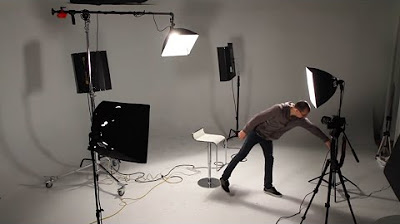Lighting with Zach King
Summary
TLDRIn this video, the host explains the basics of three-point lighting, essential for any film or production class. They detail the roles of the key light, fill light, and hair light in setting the scene and enhancing the subject's appearance. The video also touches on the importance of using natural daylight temperatures and offers a quick tip for lighting outdoor interviews. Additionally, the host discusses the 'Golden Hour,' the optimal time for filming due to its beautiful, natural lighting.
Takeaways
- 💡 The video covers the basics of three-point lighting, commonly used in film production for lighting subjects like people or products.
- 🔑 The key light is the most important, casting the most light on the subject. In this setup, the speaker is using 85-watt bulbs.
- ✨ The fill light is softer and diffused, reducing shadows created by the key light. It uses fewer watts and a whiteboard for diffusion.
- 🎥 The hair light is used to separate the subject from the background, creating a professional and cinematic look.
- 🕵️ The speaker suggests using practical light sources on set to make lighting look natural, a common Hollywood technique.
- 🌞 The lighting setup in this video uses natural daylight temperatures to match the lighting outside the windows.
- 🎨 The speaker emphasizes the importance of matching color temperatures to avoid clashes between warm and cool tones.
- ⚖️ Light intensity can be controlled by either moving the light away from the subject or using diffusion materials if no dimmer is available.
- 💺 For outdoor interviews, the speaker recommends using simple tools like bounce boards and stands for effective lighting.
- ⏳ Golden hour is an optimal time for shooting, but the limited timeframe means you may need multiple days to capture all the shots.
Q & A
What is the three-point lighting setup mentioned in the script?
-The three-point lighting setup consists of a key light, a fill light, and a hair light. This setup is fundamental in film and video production, primarily used for lighting subjects like people, animals, or products.
What is the role of the key light in the three-point lighting setup?
-The key light is the most important light in the setup as it sets the scene and provides the primary illumination. It is typically the brightest and defines the overall mood of the scene.
How is the fill light different from the key light?
-The fill light is less bright than the key light and is used to soften the shadows created by the key light. It is often diffused and helps to balance the light in the scene.
What effect does the hair light add to the scene?
-The hair light is used to create a glow around the subject, separating them from the background and giving a more professional Hollywood look to the film. It is placed behind the subject and helps to define the subject's outline.
What is the significance of using natural daylight temperatures for the lights?
-Using natural daylight temperatures for the lights ensures that the lighting matches the natural light coming from windows or the outdoor environment, avoiding a clash of color temperatures and maintaining a consistent look.
How can you make a light source seem natural in a scene?
-To make a light source seem natural, you can position it at an angle where it casts light as if it's coming from a natural source, such as a window or a lamp. This helps to sell the idea that the light is part of the set.
What is the purpose of diffusion in the three-point lighting setup?
-Diffusion is used to soften the light, reducing harsh shadows and creating a more even and pleasing lighting effect. It can be achieved through the use of diffusers or bounce boards.
Why is the golden hour important for video shooting?
-The golden hour, which occurs about an hour before sunset, provides a beautiful, warm light that enhances the visuals in videos. It is often used in wedding videos and other productions where a soft, flattering light is desired.
What is a quick tip for lighting an outdoor interview?
-A quick tip for lighting an outdoor interview involves using a C-stand with a bounce board to reflect light onto the subject, ensuring that they are well-lit against a potentially dark background.
How can you adjust the brightness of the lights if you don't have a dimmer?
-If you don't have a dimmer, you can adjust the brightness of the lights by moving them further away from the subject or by using diffusion techniques to soften and spread the light.
What is the challenge with shooting during the golden hour?
-The main challenge with shooting during the golden hour is the limited time available. The window of opportunity is short, and you must complete the shoot before the sun sets, which can be difficult if you're trying to capture all the necessary shots.
Outlines

Cette section est réservée aux utilisateurs payants. Améliorez votre compte pour accéder à cette section.
Améliorer maintenantMindmap

Cette section est réservée aux utilisateurs payants. Améliorez votre compte pour accéder à cette section.
Améliorer maintenantKeywords

Cette section est réservée aux utilisateurs payants. Améliorez votre compte pour accéder à cette section.
Améliorer maintenantHighlights

Cette section est réservée aux utilisateurs payants. Améliorez votre compte pour accéder à cette section.
Améliorer maintenantTranscripts

Cette section est réservée aux utilisateurs payants. Améliorez votre compte pour accéder à cette section.
Améliorer maintenant5.0 / 5 (0 votes)






